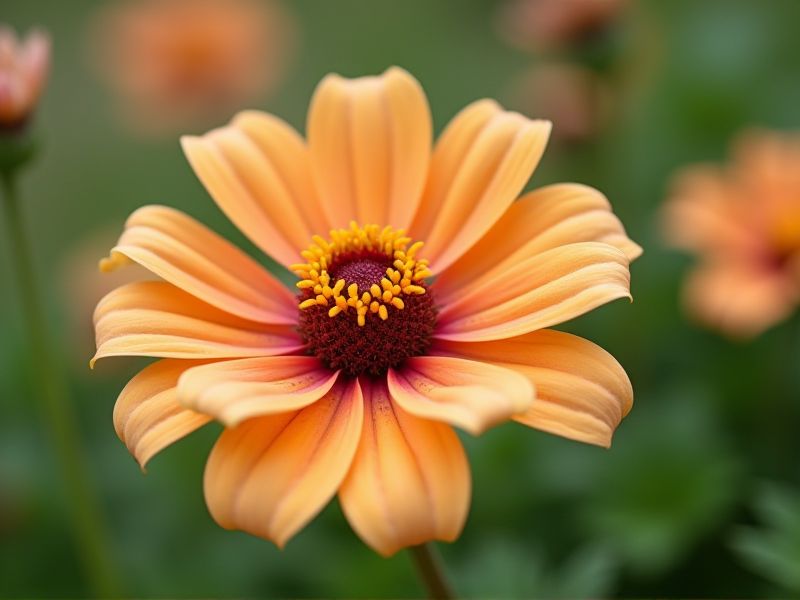
Beginners can successfully grow several flowering plants that require minimal care and thrive in various environments. Marigolds are vibrant, hardy annuals that bloom from spring until frost, attracting beneficial pollinators while deterring pests in your garden. Zinnias, known for their bright hues, offer a long blooming season and are drought-tolerant, making them ideal for less frequent watering. Pansies display stunning colors and can endure cooler temperatures, providing early spring blooms to brighten your landscape. Lastly, petunias are versatile and come in various colors, thriving in containers or beds, making them perfect for new gardeners looking to enhance their outdoor spaces.
List of some Flowering plants that are easy for beginners
- Spider Plant (Chlorophytum comosum)
- Peace Lily (Spathiphyllum spp.)
- African Violet (Saintpaulia spp.)
- Marigold (Tagetes spp.)
- Geranium (Pelargonium spp.)
- Nasturtium (Tropaeolum majus)
- Zinnia (Zinnia elegans)
- Petunia (Petunia spp.)
- Snapdragon (Antirrhinum majus)
- Pansy (Viola tricolor)
Important things about Flowering plants that are easy for beginners
Photosynthesis Process
Photosynthesis in flowering plants is a vital process where these organisms convert sunlight, carbon dioxide, and water into glucose and oxygen. During this process, chlorophyll, the green pigment found in leaves, captures sunlight and facilitates the conversion of light energy into chemical energy. This occurs mainly in the chloroplasts of plant cells, where light-dependent reactions take place, producing energy-rich molecules. Your understanding of photosynthesis can foster appreciation for the role flowering plants play in providing oxygen and food, essential for life on Earth.
Flower Structures
Flowering plants showcase a variety of enchanting flower structures, making them ideal for beginners in botany. The basic anatomy includes key components such as petals, sepals, stamens, and carpels, each serving essential functions for reproduction. Petals attract pollinators with their vibrant colors and enticing scents, while sepals protect the developing bud. Understanding these structures can enhance your appreciation of floral diversity and the role flowers play in ecosystems.
Pollination Methods
Pollination in flowering plants can be achieved through several beginner-friendly methods, ensuring successful reproduction and growth. One common approach is using pollinators like bees, butterflies, and birds, which are naturally attracted to vibrant flowers and sweet nectar. Hand pollination is another effective technique where you gently transfer pollen from the male part (anther) of one flower to the female part (stigma) of another using a small brush or your finger. By understanding these methods, you can foster a thriving garden ecosystem and enhance the yields of your flowering plants.
Seed Dispersal Mechanisms
Seed dispersal mechanisms in flowering plants are essential for their reproduction and survival. Common methods include wind dispersal, where lightweight seeds are carried by air currents, and animal dispersal, in which animals consume fruits and excrete seeds in different locations. Water dispersal involves seeds floating on water currents to reach new areas, while explosive mechanisms, such as those seen in plants like the touch-me-not, eject seeds forcefully from pods. Understanding these mechanisms enhances your appreciation of biodiversity and the ecological roles these plants play in their environments.
Types Of Flowering Plants
Starting your journey into flowering plants can be rewarding with easy-to-care species like Marigolds, which are known for their vibrant colors and pest-repelling properties, making them excellent companions in the garden. Sunflowers are another beginner-friendly option, thriving in various soil types and attracting pollinators, ensuring a lively garden atmosphere. Petunias offer a stunning variety of colors and fragrances, flourishing in full sun with minimal maintenance. Lastly, Geraniums are hardy and versatile, perfect for containers or flower beds, providing long-lasting blooms throughout the growing season.
Soil Requirements
Choosing the right soil is crucial for the health of flowering plants, especially for beginners. Well-draining soil, such as a mix of potting soil and perlite, promotes proper aeration and prevents root rot. Many flowering plants thrive in slightly acidic to neutral pH levels, typically ranging from 6.0 to 7.0, making it essential to test your soil before planting. Incorporating organic matter, like compost, not only enriches the soil but also enhances moisture retention, creating an ideal environment for growth.
Watering Needs
Flowering plants suitable for beginners often have straightforward watering needs that make them accessible for novice gardeners. For instance, the hardy Geranium thrives in well-drained soil and only requires watering when the top inch feels dry, preventing overwatering, which can lead to root rot. Similarly, Marigolds are drought-tolerant and prefer infrequent watering, making them ideal for those who might forget to water regularly. By focusing on these low-maintenance plants, you can cultivate a colorful garden without the stress of complicated watering schedules.
Sunlight Preferences
Flowering plants such as marigolds, petunias, and geraniums love full sun and thrive in well-draining soil, making them perfect for beginner gardeners. These hardy species can be easily planted in garden beds or containers, flourishing with at least six hours of direct sunlight daily. To ensure optimal growth, water them regularly but avoid waterlogging, which can lead to root rot. By choosing these sun-loving flowering plants, you can create a vibrant outdoor space that brings joy and beauty to your garden.
Common Diseases And Pests
Flowering plants are susceptible to a variety of common diseases and pests that can hinder their growth and vibrancy. Fungal infections, such as powdery mildew and root rot, often thrive in overly humid conditions, leading to wilting and yellowing leaves. Common pests like aphids, spider mites, and whiteflies can infest your plants, sucking vital nutrients and causing stunted growth. Regular monitoring and employing methods like neem oil or insecticidal soap can help keep your flowering plants healthy and thriving.
Basic Pruning Techniques
Basic pruning techniques for flowering plants are essential for promoting healthy growth and vibrant blooms. To start, focus on removing dead or damaged branches, as this encourages new growth and helps prevent disease. Make clean cuts just above a node, which is the point where leaves or branches emerge, to stimulate fresh growth. Seasonal pruning, typically done in late winter or early spring, can enhance flowering performance, so timing is key for optimal results.
